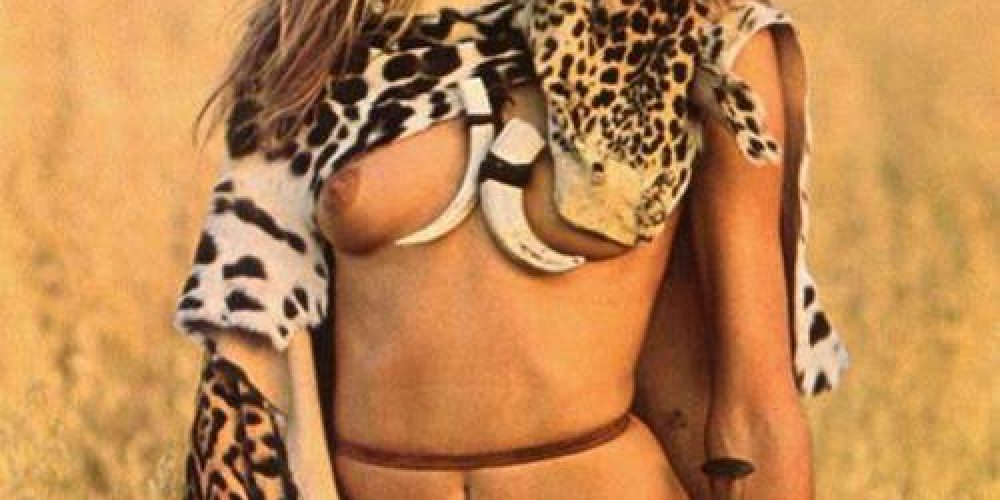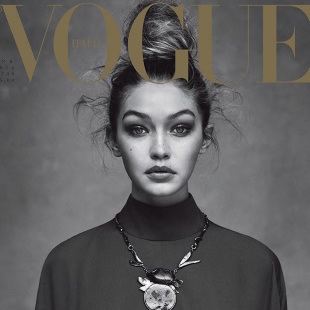In February of 2013 images from a fashion editorial called “African Queen” appeared online, sparking a debate about cultural appropriation and creative license. The series of images depict a young, Caucasian woman wearing dark-brown make-up, vibrantly printed fabrics, and accessories reminiscent of Arab and African traditional dress. The model is positioned in stoic, regal, and dance-like poses against a grey studio backdrop. The “African Queen” editorial calls awareness to ethnic representation in fashion. In analysing such images, models and non-models alike can develop an understanding of why the fashion industry has failed to shy away from eurocentrism. I’ll pay particular attention to the implications of the images, and the creative team’s intent.
What does the editorial say about race, beauty, and voice? What does the controversy reveal about the fashion industry’s attitudes towards issues of representation? What was the rationale behind the casting, wardrobe, make-up, and editorial choices? Who is ultimately responsible for the offensive nature of the images? How can an industry built on art, craft, and advertising reconcile respectful representation with creative freedom?
This eleven-image editorial is full of Eurocentric imagery. The clothes speak to reductive, Orientalist interpretations of African and Middle Eastern dress without any indication of credible knowledge of the traditions referenced. Most obviously, the model cast in the “African Queen” editorial is neither African nor of African descent. Rather, she is a 16-year-old Caucasian model from the United States named Ondria Hardin.
Racist Intent
“African Queen” photographer Sebastian Kim released an apology following the online outcry, in which he explains his creative intent and defers responsibility to the editors of Numéro. He states, “We at no point attempted to portray an African woman by painting her skin black. We wanted a tanned and golden skin to be showcased as part of the beauty aesthetic of this shoot.” He wrote that the aesthetic that inspired the images were 1960s editorials of models such as Talitha Getty, Verushka, and Marissa Berenson and “middle eastern and Moroccan fashion inspiration.” He also states that he believes that the title, which he was not aware of prior to publication, furthered “people’s misconceptions about these images.”
In regards to the “African Queen” editorial, some online commenters have suggested that if the photographer wanted to portray a girl with darker skin, they should have hired a dark-skinned model. But that the model in the images is obviously Caucasian is at the heart of the artistic intent. The character portrayed by Hardin is an aspirational figure – a wealthy woman at liberty to vacation in a beautiful (if unspecified) country. To portray leisure effectively, the character has to appear to be wealthy, and distinctly not Arab or African. If an African, Arab, First Nations, or Latina model were employed for this editorial, the implied leisure would be compromised as the reader might mistake the character for a local. The editorial is trying to sell a tropical, luxury escape – not a local woman reveling in her local culture, nor a middle-aged, khaki-wearing tourist. The character is an outsider “submerged” in the culture.
Other online commenters argued that the editorial is not racist but, in fact, promotes a positive message of African and Middle Eastern culture and beauty. The character is supposed to appear sympathetic to the beauty of the indiscriminate local culture as she wears their textiles and allows her skin to tan. However, the African-Arab-style clothing (and skin colour) just signals a cosmopolitan and global image to the reader, which is a common image that the fashion industry wants to promote. As McCannell writes, there’s a touristic desire “to go beyond the other ‘mere’ tourists and to a more profound appreciation of society and culture.” This applies to the character constructed by the creative team, as well as the fashion industry as a whole. African and Middle Eastern culture is not portrayed in this editorial because Eurocentric interpretations of those cultures show ancient, diverse traditions as removed from their traditions.
McCannell writes that, in fashion, creative and curious minds, “[scavenge] the earth for new experiences to be woven into a collective, touristic version of other peoples and other places.” But the rock left unturned hides a critical understanding of the experiences drawn upon and the implications of the images they create. These experiences are further removed from reality by their translation into two dimensional magazine images and thus the magazine reader is even more deeply alienated from the reality of the culture they now believe they admire. Instead, they admire a fiction, and later, as tourists themselves, will prefer to cling to their delusion rather than explore and enjoy the location.
Numéro also published a press release that defends the images on the basis that they’re “in line with his [Kim’s] previous photographic creations, which insist on the melting pot and the mix of cultures, the exact opposite of any skin color [sic] based discrimination.” This demonstrates a profound ignorance of critical media analysis. Cultural mixing isn’t immune to race-based discrimination, as Numéro claims. It can assist in cross-cultural understanding and education, so long as the traditions involved are used and not taken out of context or exploited. In the case of the Numéro editorial, the clothing worn is the work of mainly European or American designers who have appropriated Middle-Eastern, Indian, and African elements of dress ignorant of the histories of the garments referenced. In this editorial, cultures are not mixed so much as inappropriately and inaccurately borrowed for the sake of a deeply decontextualized aesthetic.
Numéro countered the accusations of racism by citing their frequent use of non-white models. The press release states that their use of black models, “demonstrates the completely inappropriate nature of the accusations made against our magazine,” and that the magazine is “deeply committed to the respect for differences, tolerance and more generally to non- discrimination.” The argument is weak, especially considering that out of the 141 issues of French Numéro, three issues featured a non-white model on the cover. In 2012, all twelve cover-models were of European descent. An unequal ratio like this doesn’t indicate that this publication is “deeply committed” to non-discrimination.
Artistic Intent
Using ignorance as a defence is further complicated when one considers the reference images. The reference images (1960s editorials of models Talitha Getty, Verushka, and Marissa Berenson) are very Eurocentric themselves. By paying homage to 1960s Eurocentric magazine images, the 2013 images inherit decades of Orientalist prejudices. They reinforce a visual tradition that has been widely acknowledged as unacceptable in common knowledge.
The images included are among the class of images that inspired Sebastian Kim’s 2013 work for Numéro. I have included the image on the right to demonstrate how very dark German model Verushka’s skin has been photographed and the origins of Sebastian Kim’s rationale for using such dark make-up on Ondria Hardin in the 2013 editorial. The images on the next page are included to illustrate the tradition of exoticism that Kim’s team drew from. They exoticize places such as Morocco and privilege a twentieth-century white, leisure class at the expense of an indiscriminate Orientalist ‘other.’
I would never blame Ondria Hardin for this. It’s difficult enough for new faces to assert their basic human rights on set, let alone suggest creative direction or question the entirety of the project. Furthermore, she was only abour 16-years-old at the time of shooting, from which we can assume she had an incomplete high school education let alone a university-level understanding of the role of the media in race relations. Although models can be active participants in the creative process, their input is still limited by the fact that a model is hired to model, not to photograph or direct.
Therefore the ethics of the images produced are not the model’s responsibility. However, if a model feels that participating in a certain project will compromise their values (be it fur, nudity, cigarettes, or racism) a model has the freedom to politely decline.
In my short, four-year modelling career I observed ignorant casting and styling choices that went unnoticed for their Euro-centric imagery: appropriation of First Nations war bonnets, sexualized geisha imagery, and a collection of patterned trousers described as being inspired by “African safaris and tribalism.” These decisions would have been quickly put down had the creative director had had even a cursory knowledge of cultural appropriation and its consequences. Accounting for the morphology of images presented and preventing offensive editorial content is not on the average editorial agenda.
Steps forward
While the images are technically beautiful, and there does not seem to have been any racist intent on the part of Numéro or the creative team, any kind of textual analysis appears to have also been absent during the creative process. Ignorance such as this occurs all too frequently in the fashion world, and is at the heart of the problem. I would thus like to suggest a plan of action to prevent further images, such as “African Queen,” from going to print.
Firstly, I propose that publishing companies hold seminars for the creative directors of their magazines to have better-informed executive decisions made on-set. By increasing education, creative directors can work with photographers, hair and make-up artists, models, and stylists to produce images that are culturally respectful but still achieve images that are commercially viable.
Secondly, I propose that Magazines create positions for Ethics Advisors or Editors. This employee would be educated in cultural studies and ethics (at the Master’s level at the very least) and would review editorial proposals and approve all images before they are sent to print. Being more educated in cultural criticism than creative directors (who also have much larger responsibilities), this person would be responsible for collaborating with the creative director to ensure that mistakes are not made on set, and to catch anything that did make it into post-production.
The above proposals would reduce the amount of culturally insensitive material photographed, and would ensure that all editorials are appropriate before going to print. Increasing the intellectual contribution to fashion images will increase product quality. This could be the fashion industry’s Corporate Social Responsibility initiative.
Although unintentional, “African Queen” effectively displays unequal 1960s power relations, and re-imagines them for 2013. This tells the reader that nothing has changed in how Europe and North America see the Middle East and Africa over the last half century. There is room for change without having to sacrifice the beautiful, innovative images readers have come to love, if executives choose to embrace greater image literacy.
Definitions
Cultural Appropriation — The use of certain traditional or sacred cultural symbols for the purposes of aesthetics where the appropriated object, symbol, practice, etc. is removed from its original meaning and replaced with new meanings that are significantly different from those they originally held.
Eurocentrism – The focus on European culture/history/world view to the exclusion of other worldviews – notably indigenous worldviews and non-Christian worldviews from the Americas, Africa, Asia, and the Middle East.
Cultural mixing – The existence of multiple religious, linguistic, and cultural practices existing within the same society or space.
Orientalism – The imitation or depiction of aspects of Middle Eastern, and East Asian cultures by American and European writers, designers and artists, which essentialize these societies as undeveloped and unsophisticated and therefore creating the view that these culture can be freely studied, depicted, and reproduced.
Exoticism – The influence of perceived “foreign” cultures on visual art, music, and décor, which represent (and often appropriate) one culture for the consumption of another. Emerging in the imperial period, Exoticism emphasizes cultural difference, power hierarchies, and often dehumanizes the subject culture.






